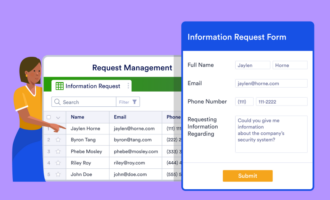Each business has a responsibility to ensure that the workplace is safe for everyone onsite, with protocols to reduce the risk of injury and accident.
Even if you’re proactive with adequate safety measures, you can’t eliminate the possibility of an injury. It’s crucial for you to be prepared for anything that might happen. A good incident reporting process is an essential way to track and manage these issues when they occur.
The incident reporting process
An incident report collects and stores the details of an event. For example, when an illness, an injury, or damage occurs at the workplace, you need to keep track of information related to the incident.
An incident report helps you organize information, and incident reporting can help track potential hazards in the workplace. You can proactively use information from incidents to keep accidents from happening.
Usually, an incident report is specifically for injuries or accidents. But these forms can also be helpful in other situations, such as documenting near-miss accidents, COVID-19 exposure, first aid administration, workplace misconduct, security breaches, or property damage.
The importance of incident reporting
A good reporting system is a foundational element of an effective workplace safety plan. By creating a safe work environment, you ensure that your employees can thrive and your business can grow.
Incident reporting is essential to proactively identify potential threats or risks. This system also helps discourage dangerous activity. For example, if someone files a report because an employee failed to use the proper safety equipment, they increase the likelihood that everyone will comply with guidelines in the future.
Having processes in place to track and manage incidents will also increase the team’s awareness of hazards and safety practices. In addition to creating an effective incident reporting system, prioritize training each employee to use the reporting system when necessary.
Implementing an incident reporting system in your business is a great way to save both time and money. Addressing potential threats and reducing common hazards decreases the costs and the amount of time commonly lost because of work-related injuries.
Essential details in an effective incident report
When designing an incident report form, make sure it covers as many details as possible. Successful incident reports include
- The type of incident
- The time and date of the incident
- Names of the victims
- Names of any witnesses
- A general description of the situation
- The sequence of events
- The type of injuries
- Required medical treatments
- Video or photo evidence of the injury
Design your incident report forms by focusing on essential questions to gather facts about the situation: who, what, when, where, why, and how.
Effective incident reporting workflow
The great thing about digital forms is that anyone can fill them out, whether they’re victims or witnesses of an accident. Making it easier for team members to access these forms increases the chances that they’ll report hazardous conditions that could lead to injury in the future.
While collecting information through your incident reporting forms is an effective way to keep on top of issues, it’s just as important to have a system in place for managing the data you collect.
Automated features can make it easier to assign a manager or human resources representative to review and resolve an incident. These workflow details ensure the team manages every incident report quickly and thoroughly.
Jotform for incident reporting
Jotform is an ideal solution for creating an incident reporting process. These no-code tools make it easier for businesses and HR departments to collect incident information through digital form templates.
Select from a wide range of employee incident report forms like these:
- Employee accident report form
- Disciplinary action form
- Damaged equipment form
- Coronavirus case report template
- Contingency plan checklist
These forms make it easy to collect incident reporting data. You can also use Jotform table templates to track and manage incident reports, as they store your form data in a single database Approval templates keep the team on track with incident management and a workflow that automates the process.
Use these tools to customize the ideal incident reporting process to match your business needs. These digital solutions help maintain communication through every stage of the process.













































































Send Comment: